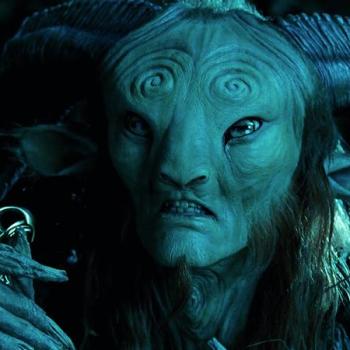
Let’s get one thing clear from the start: the new Suspiria is a strange, horrible, beautiful, sprawling, and challenging film. And oddly enough, that’s a good thing.
Dario Argento’s original 1977 film is in a class of its own. It’s a baroque fantasia of geometry and magic and blood, suffused with vivid colors and backed by Goblin’s twinkling prog-rock theme. At the same time, though, it never really strives to rise above the category of surrealist pulp—from beginning to end, one never doubts what sort of movie they’re watching. Argento’s vision is one of artistic horror, but horror nevertheless.
Luca Guadagnino’s 2018 reinterpretation is something quite different. In place of Argento’s hyper-stylized tableaus, Guadagnino offers a muted palette. In place of Argento’s wild, dizzying camera angles and visceral cinematography, Guadagnino substitutes an alienated cinematic gaze, one that never truly grows intimate with its subjects. In lieu of Argento’s dreamlike forest setting, Guadagnino stages his film in the heart of divided 1970s Berlin. And where Argento’s film leaned fully into its macabre sensibilities, Guadagnino’s Suspiria swings for the fences, thematically speaking.
Both films share the same broad narrative arc: American ballerina Susie Bannion (played here by Fifty Shades’ Dakota Johnson) arrives at a mysterious ballet school helmed by stern taskmistresses. She soon learns that the academy has a problem with student disappearances. Ballerinas routinely go missing, their absences noted and perfunctorily dismissed by their teachers. And then, all too suddenly, it becomes clear that the school is no school at all: it’s the front for a coven of ancient witches hellbent on extending their lives at whatever cost. (That’s not a spoiler—this general plot structure is made pretty clear early on in both films.)
Beyond that common storytelling skeleton, though, the two movies have very little in common—particularly where their underlying philosophical visions are concerned. At least at its start, Guadagnino’s Suspiria offers a filmgoing experience totally devoid of the transcendent. Gone are Argento’s ethereal dreamscapes and misty glamours: reality here is grim, brutish, and wearying.
Nowhere is this more clearly seen than in the film’s dance sequences. Few are accompanied by music; instead, the sound design homes in on the thick weighty energy of matter moving rapidly through space. There’s no dissolution of the self into any greater whole, into a complex fusion of music and movement and storytelling. There is only flesh in motion. And as we behold every creaking joint, every strained gasp for air, and every cracking knuckle, we confront the raw physicality of ballet in a tangible way. We feel every lunge and pirouette as Guadagnino’s performers hurl themselves into their art.
That is, if art is actually the right word here. In fact, that’s precisely the question Suspiria wants us to ask. “Dance can never again be beautiful or cheerful,” declares the academy’s Madame Blanc (Tilda Swinton). “You must break the nose of the beautiful.”
One might reasonably ask what she means by this—and the film’s historical and political backdrop provides a dreadful answer. Guadagnino’s Germany is a Germany profoundly scarred by—and yet failing to reckon with—the unimaginable horror of the Holocaust. This cultural stain simmers and seethes beneath the surface of Suspiria, a memory of evil incarnated within the bodies of a whole society. In the wake of that nightmare, what room does such a broken world have for any sublime beyond, something beautiful toward which art points? In the grotesque shadow of the Third Reich, all the old narratives of cosmic good and evil have been made manifest in the finite.
The actual witchery at work here reflects the film’s rootedness in real history. Most tales of the occult, regardless of author, situate their sorcerers at the edge of a spiritual abyss of sorts: the mage has insight into, and access to, an unseen world governed by its own logic and principalities and powers. Black magic, one might say, plays by its own rules. Those rules, alien though they may be, force the sorcerer to conform to an order beyond himself, even as he rejects the constraints of his terrestrial society. Goethe’s Faust is the archetypal example: in selling his soul to the Devil, he sets up a logical series of consequences stemming from his fatal bargain.
But not so in Guadagnino’s Suspiria. The witches’ magic on display here is—perhaps paradoxically—an anti-transcendent magic, solely concerned with the manipulation of human bodies. Suspiria’s witches call on their powers to empower or destroy hands and feet, to distort bodies into dislocated wrecks, and to harvest organs from living flesh…but never to call spirits or tap the resources of a world truly beyond their own. Theirs is less a kind of magic than it is a “technology of the body” in the Foucaldian sense. It regulates and compels physical forms to submit and yield before a greater power—echoing, in grisly fashion, the embodied principles of fascism.
When everything becomes reducible to a tangle of bodies, power, and iron will, the beautiful—as Madame Blanc reminds us—is no longer accessible. There can only be art that reflects the chaos of one’s age.
(Spoilers follow)
But Susie disagrees. In a critical dance scene midway through the film, she becomes the linchpin of an unfolding performance entitled Volk (not coincidentally, a name for the German people that is often associated with Nazism). Dissatisfied with the aesthetic nihilism of her teachers, she changes the nature of the group performance—introducing elements that emphasize unity and harmony over disconnection and dissolution. The academy’s mistresses immediately shut her down, but Susie isn’t through.
At the film’s climax, Susie reveals herself to be the Mater Suspiriorum, an ancient elder witch who may or may not be a deity of sorts. Calling forth a hulking skeletal apparition from the catacombs beneath the school, Susie obliterates—in horrifyingly grisly fashion—the bodies of the mistresses who sought to command and control their students. Their puny technologies of power are of no use against her supernatural might.
“Beautiful,” Susie whispers as bodies hit the ground around her and the surviving students begin to dance in a new pattern. It’s a haunting, and unforgettable, coda.
And so Guadagnino’s Suspiria, in the end, subverts and repudiates the sterile materialism of its start. The genuinely transcendent, we see, cannot be restrained and confined to a discourse of manipulation and power. It inevitably breaks free—and when it does, it overwhelms any scheme that fails to think beyond first-order carnality. In a strange sense, Suspiria’s Grand Guignol finale recalls the climax of Raiders of the Lost Ark: the wrath of “God” is poured out against the utterly unrighteous, who have failed to grasp that they cannot control it.
One thing, however, must be made clear: this encounter with the “unmasked transcendent” is a profoundly pagan encounter. There is no hope, or grace, offered here—only the pure terror of annihilation by an overwhelming, all-consuming Unknown. Early on in Suspiria, one character references attending a lecture by Jacques Lacan, a prominent French psychoanalyst whose work has shaped decades of Continental philosophy and European Marxist thought. Central to Lacan’s thinking was the notion that the Real—what earlier Christian thinking would likely have termed actus purus, God understood as the source and fullness of all finite being—is actually the ground of psychological trauma. Encountering the absolute and infinite, Lacan held, inevitably wounds the psyche. And so what was once “holy dread” becomes an object of therapy; the Creator’s omnipresence becomes an awful specter whose effect on the mind must be cognitively blunted.
It is precisely that reaction to the Real—alienation instead of awe—that informs Guadagnino’s idea of transcendence. One feels no impulse toward reverence or sacred wonder when Suspiria’s truly supernatural forces manifest themselves (contra, for instance, Guillermo del Toro’s The Shape of Water, whose conclusion did allow for such a response). One experiences only sheer hopeless dread. The premise of so much Christian thought—that existence is a gift, and that the truly transcendent is also the source of goodness and love—is inverted: here, to be human is to be either a pawn of petty authoritarians or a vessel of wrath before an angry alien god. Existence, in short, is a curse.
Which of those two outcomes is worse? Guadagnino doesn’t answer that question, but in the bloody aftermath of the Holocaust, countless souls confronted it. It is a dilemma resolved only, one might say, by the very mystery at the heart of this Christmas season—the participation within creation of the Infinite incarnate, coming not to deal death but to suffer it.
None of this critique is to deny how remarkable a film this Suspiria really is. Guadagnino’s vision is strikingly ambitious, ranging across topics as diverse as art, philosophy, femininity (there’s a lot here, but I’m not the best person to expound on it), cultural memory, guilt, and faith. That said, most people won’t enjoy it—it should be obvious by this point, but this is very much a niche movie for people with pretty strong stomachs.
Perhaps that describes you, though—and in that case, this may be exactly the sort of thought-provoking experience you’ve been searching for at the cinema this year. I, for one, would rather watch a movie that strives with too many Big Questions than too few. And this Suspiria is certainly such a film.












